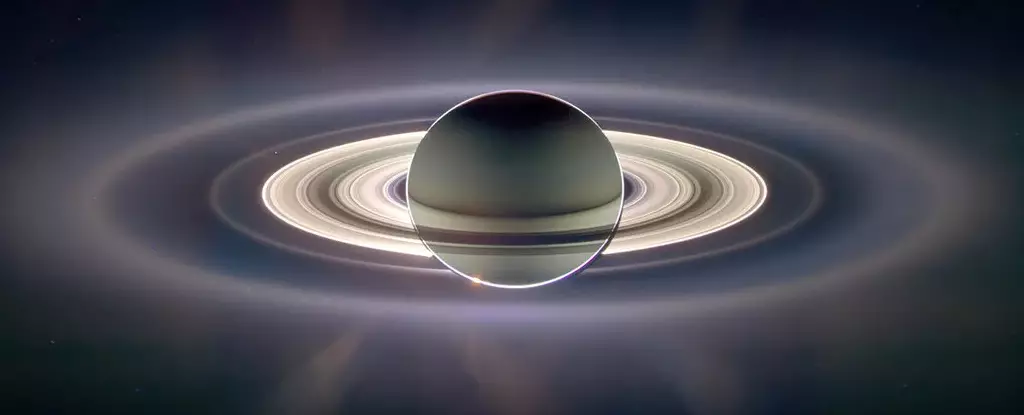Saturn’s rings stand as one of the most captivating features in our solar system, sparkling with an ethereal beauty that has fascinated astronomers and enthusiasts alike. While initial observations led scientists to believe that these rings were relatively young—formed only a few hundred million years ago—recent research suggests a deeper, more complex history might be at play. This article delves into the transformative discoveries regarding the age and composition of Saturn’s iconic rings, examining how our understanding has evolved over time.
When the Cassini spacecraft entered orbit around Saturn in 2004, researchers anticipated acquiring valuable insights about the planet and its mesmerizing rings. However, one of the most surprising findings was the unexpected cleanliness of the ring material. Contrary to what scientists had predicted, the icy particles that make up the rings were surprisingly devoid of the fine dust typically resulting from relentless micrometeoroid impacts over billions of years. This absence led to a tantalizing hypothesis: perhaps Saturn’s rings were relatively recent formations, having materialized only during the last 100 to 400 million years—a blink in the cosmic timeline.
This conclusion painted an intriguing picture of a ringless Saturn gliding through the cosmos during the age of dinosaurs, a thought that sparked both curiosity and concern among scientists. Ryuki Hyodo, a planetary scientist at the Institute of Science Tokyo, expressed the significance of this assumption in his study, stating, “Many people simply accepted that conclusion. However, our theoretical work now shows that a clean appearance does not necessarily mean the rings are young.” Such revelations invite us to reconsider our assumptions regarding celestial bodies and their histories.
To probe deeper into the enigmatic nature of Saturn’s rings, Hyodo and his fellow researchers conducted sophisticated theoretical modeling. They sought to answer a critical question: Could there be an alternative explanation for the rings’ pristine appearance? By simulating high-speed impacts between micrometeoroids—particles smaller than 100 microns—and the larger ice chunks comprising the rings, they unveiled significant findings.
Their simulations revealed that, instead of polluting the icy surfaces, the heat generated during these high-velocity collisions caused both the micrometeoroid and a tiny portion of the ice to vaporize. This process leads to the formation of nanoparticles and charged atoms in the magnetic field surrounding Saturn. The results indicated that rather than deteriorating over time, Saturn’s rings are remarkably resilient, minimizing darkening despite continuous impacts from high-speed particles.
If Hyodo’s research holds up under further scrutiny, Saturn’s rings could be billions of years old, casting serious doubt on the previously held notion of their ephemeral existence. This discovery has consequential implications not just for Saturn but for our understanding of other celestial bodies and potentially ringed planets beyond our solar system.
Historically, researchers have linked the observed phenomenon of “ring rain,” in which substantial volumes of water are seen falling from Saturn’s rings towards the planet, to the rings’ decay. With new insights suggesting that this water could instead arise from vaporized material during micrometeoroid impacts, scientists are faced with a new paradigm that reconciles the idea of ancient rings with persistent activity.
The implications of this revised understanding are far-reaching. The early solar system was tumultuous, filled with collisions between asteroids and nascent planets. Such chaotic events may have contributed to the formation of the icy structures that became Saturn’s rings. As Hyodo emphasizes, “The Solar System was much more chaotic billions of years ago, increasing the odds of an event such as a collision that created clouds of debris.” This framework could clarify many enduring questions surrounding Saturn’s history, particularly the origins of its breathtaking rings.
To further explore these groundbreaking notions, the ongoing work of Hyodo and his colleagues includes laboratory experiments aimed at simulating micrometeoroid impacts on icy particles. By employing these experimental methodologies, they hope to validate their theoretical findings, thus enhancing our understanding of Saturn’s rings and the complex environment in which they reside.
The ongoing investigation into the age and composition of Saturn’s rings has redefined our understanding of one of the solar system’s most iconic features. While initially thought to be young and ephemeral, new research proposes that they may very well be ancient, challenging our assumptions and sparking further inquiries into their history. As scientists continue to gather evidence and conduct experiments, we may soon unravel more secrets hidden within Saturn’s remarkable rings, giving us a deeper insight into the majesty of our universe.


Leave a Reply